Kate Lawrence's Blog, page 4
March 19, 2014
Veganomics
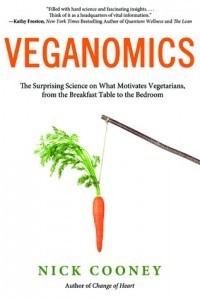 Veganomics: The Surprising Science on What Motivates Vegetarians, from the Breakfast Table to the Bedroom, by Nick Cooney. Lantern Books, 2014.
Veganomics: The Surprising Science on What Motivates Vegetarians, from the Breakfast Table to the Bedroom, by Nick Cooney. Lantern Books, 2014.
A very helpful little book for veg activists, Veganomics brings together data collected in recent years about a number of topics, such as: what motivates people to reduce or eliminate meat consumption (answer: primarily animal cruelty and health concerns), what demographic group is most likely to go vegetarian (young women), what are the most effective ways to tailor vegetarian outreach to make it appealing to people (one example: refer to food as “meat-free” instead of “vegetarian”), why to emphasize cutting out chicken, fish and eggs instead of red meat (chickens and fish account for 92% of the farm animals killed for food in the U.S. and represent 95% of the days of animal suffering caused each year by omnivores).
Again, all the topics in the book are approached in terms of actual scientific studies involving real people; it’s not just someone’s guess or opinion. There’s much more: what factors influence the choice to eat meat analog products? Why are there so many more female vegetarians than male? Is it effective to use graphic images of farm animal cruelty? What are the barriers for people to give up meat and how can we overcome them? And, as alluded to in the book’s subtitle, do vegetarians have better sex lives?
Everyone who cares about farm animals and the planet, and wants to know maximally effective strategies to persuade people away from meat, should pick up this book.
(Note: Despite its title, Veganomics does not discuss veg economics, the huge cost of America’s meat habit. For that topic, I recommend another excellent recent book, Meatonomic$, by David Robinson Simon. See my review at http://practicalpeacemaker.com/Kate/2....)
March 15, 2014
The Curious Incident
 The Curious Incident of the Dog in the Night-Time, by Mark Haddon. Doubleday, 2003.
The Curious Incident of the Dog in the Night-Time, by Mark Haddon. Doubleday, 2003.
This easy-to-read engaging novel will help most readers deepen their empathy for people who are “different.” Told in the first person by Christopher, a teenaged autistic boy, we come to live inside his head and understand a little of what it would be like to view the world as confusing and overstimulating, people as untrustworthy, and advanced math as a refuge inside his mind against the discomfort of everyday life. We also view at close range the considerable difficulties that parents have in raising these kids who do not want to be touched, who have intense inexplicable preferences (e.g. Christopher hates anything that is yellow or brown), and whose behavior in public may include screaming, groaning and possibly wetting themselves.
By portraying Christopher sympathetically, and showing the boy’s amazing abilities in math and science, the author advances the cause of handicapped people everywhere.
February 6, 2014
The Invention of Wings
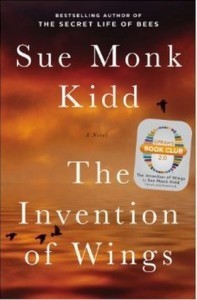 The Invention of Wings, by Sue Monk Kidd. Viking, 2014.
The Invention of Wings, by Sue Monk Kidd. Viking, 2014.
The Grimke sisters, at the center of Kidd’s new novel, were among the 19th century’s first outspoken abolitionists and feminists, yet largely forgotten today. Most abolitionists were Northerners, whose knowledge of slavery was second- or third-hand. The Grimkes, however, had grown up in a Southern slave-holding family, and thus brought a dynamic firsthand perspective about the treatment of slaves to their writings and lecture tours. Their pamphlet “American Slavery As It Is” strongly influenced Harriet Beecher Stowe, whose later widely-read novel Uncle Tom’s Cabin persuaded tens of thousands to oppose slavery.
The Invention of Wings explores themes of tradition, reform, family ties, racism, cruelty and kindness, courage, resistance, the frustratingly limited roles expected of women at the time, and the irrepressible desire for freedom. The story is appealing and the characters well-drawn. I was reminded of another recent novel dealing with Quakers, outsiders, resistance to slavery, and defying the law: The Last Runaway by Tracy Chevalier (see my review here).
As a novelist, Kidd has chosen not to adhere strictly to the historical facts; she discusses in her Author’s Note her creation of characters and events, and her alteration of some events that actually happened. She refers readers wanting a factual account to The Grimke Sisters from South Carolina by Gerda Lerner.
January 8, 2014
Meatonomic$
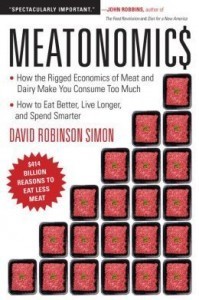 Meatonomic$: How the Rigged Economics of Meat and Dairy Make You Consume Too Much–and How to Eat Better, Live Longer, and Spend Smarter, by David Robinson Simon. Conari Press, 2013.
Meatonomic$: How the Rigged Economics of Meat and Dairy Make You Consume Too Much–and How to Eat Better, Live Longer, and Spend Smarter, by David Robinson Simon. Conari Press, 2013.
What a compelling argument for the huge economic cost, estimated at $414 billion, of Americans’ high meat consumption! Eating this amount of meat–three times the world average–is made possible for Americans by huge government subsidies and the astonishing political clout of the meat industry, among other factors. This is not just a rehash of meat consumption issues–I’ve read a lot of books that are–but will help readers see things from a fresh viewpoint; i.e. how much it is costing us as a country.
That alone would make the book worth reading, but there’s more: the author is a man with a plan. It is especially encouraging to read not just a lament about what’s wrong, but a detailed proposal for how to fix it, including the imposition of taxes on animal foods, a restructure of the USDA, and adjustment of federal support programs. He anticipates and discusses objections that may arise. Several appendices along with detailed endnotes and an index make it even more useful.
Reviewers’ superlatives–”spectacularly important” (John Robbins) and “ranks [with] . . . The China Study in its power to expose the truth” (Patti Breitman)–are well-earned. It’s only 185 pages: read it!
Meatonomics
 Meatonomics: How the Rigged Economics of Meat and Dairy Make You Consume Too Much–and How to Eat Better, Live Longer, and Spend Smarter, by David Robinson Simon. Conari Press, 2013.
Meatonomics: How the Rigged Economics of Meat and Dairy Make You Consume Too Much–and How to Eat Better, Live Longer, and Spend Smarter, by David Robinson Simon. Conari Press, 2013.
What a compelling argument for the huge economic cost, estimated at $414 billion, of Americans’ high meat consumption! Eating this amount of meat–three times the world average–is made possible for Americans by huge government subsidies and the astonishing political clout of the meat industry, among other factors. This is not just a rehash of meat consumption issues–I’ve read a lot of books that are–but will help readers see things from a fresh viewpoint; i.e. how much it is costing us as a country.
That alone would make the book worth reading, but there’s more: the author is a man with a plan. It is especially encouraging to read not just a lament about what’s wrong, but a detailed proposal for how to fix it, including the imposition of taxes on animal foods, a restructure of the USDA, and adjustment of federal support programs. He anticipates and discusses objections that may arise. Several appendices along with detailed endnotes and an index make it even more useful.
Reviewers’ superlatives–”spectacularly important” (John Robbins) and “ranks [with] . . . The China Study in its power to expose the truth” (Patti Breitman)–are well-earned. It’s only 185 pages: read it!
January 1, 2014
Disciples
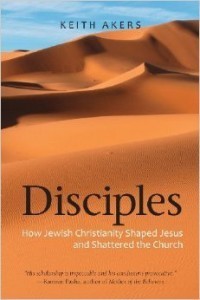 Disciples: How Jewish Christianity Shaped Jesus and Shattered the Church, by Keith Akers. Apocryphile Press, 2013.
Disciples: How Jewish Christianity Shaped Jesus and Shattered the Church, by Keith Akers. Apocryphile Press, 2013.
Following up on his previous book The Lost Religion of Jesus, Keith Akers continues his examination of Christianity in its earliest stages, presenting a very different view from what Christianity later became under Paul. This Jewish Christian movement, which practiced simple living, nonviolence and vegetarianism, has been completely lost, even though it represented what Jesus actually taught. Contemporary scholars of religion are mostly unaware of its existence, yet the author’s conclusions are based solidly on historical sources of the period. For more details, visit the the author’s blog here.
Had Christianity stayed closer to its original vision, we would likely have a kinder world in which resources would be more equitably shared and no climate/environmental crisis would be looming on the horizon. The more people who are Christian read this book and begin to work for change in their churches, the better the future will be.
December 18, 2013
Lying
 Lying, by Sam Harris. Four Elephants Press, 2013.
Lying, by Sam Harris. Four Elephants Press, 2013.
Short and easy-to-read, but not lightweight. I continue thinking about the issues raised, although it has been several days since I finished reading it. I hadn’t thought about all the small “white” lies most people tell, and whether the effect(s) such lies have on one’s personal relationships is beneficial or detrimental. I’m intrigued by the question: Is it possible in our society to live a completely truthful life?
November 20, 2013
Marc Bekoff on Vegan Activism
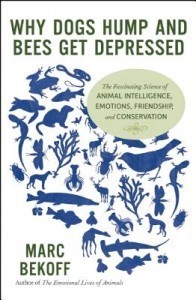 Recently I attended a talk and book signing at Tattered Cover Bookstore given by Marc Bekoff, professor emeritus of ecology and evolutionary biology at the University of Colorado, Boulder, and bestselling author. His new book is Why Dogs Hump and Bees Get Depressed: The Fascinating Science of Animal Intelligence, Emotions, Friendship, and Conservation ($15.95 New World Library). He spoke for an hour on a variety of topics, including animal intelligence, human/animal relationships, and how we humans often depreciate the skills and capabilities of non-human animals. An example of the latter is that when people misbehave, we sometimes say they are “acting like animals.” Or perhaps we might consider sounds made by another species as primitive, when actually what we are hearing is a complex language.
Recently I attended a talk and book signing at Tattered Cover Bookstore given by Marc Bekoff, professor emeritus of ecology and evolutionary biology at the University of Colorado, Boulder, and bestselling author. His new book is Why Dogs Hump and Bees Get Depressed: The Fascinating Science of Animal Intelligence, Emotions, Friendship, and Conservation ($15.95 New World Library). He spoke for an hour on a variety of topics, including animal intelligence, human/animal relationships, and how we humans often depreciate the skills and capabilities of non-human animals. An example of the latter is that when people misbehave, we sometimes say they are “acting like animals.” Or perhaps we might consider sounds made by another species as primitive, when actually what we are hearing is a complex language.
As an activist encouraging people to cut back or eliminate the consumption of meat and other animal products, I was particularly interested in what he had to say about animals used for food. In the Q & A period, I asked him how we can help people understand that the animals they eat are real animals, like the animals they care about. He advised that positive images are more persuasive than images of brutality or suffering; that is, show a photo of a cow and calf instead of the cow’s dead body being cut up. A second piece of advice: when someone asks “what’s for dinner?” rephrase it as “who’s for dinner?” as a way to connect the piece of meat on a plate with the once-living animal that provided it.
He also suggested that people who are still going to eat meat and other animal products could be encouraged to refuse the products of factory farms. (“There is no such thing as factory farms,” he said, because factory farms are not farms. Using the term is an insult to family farms.) In a grocery store or restaurant, people could ask where did this meat–or eggs, or milk–come from? If the clerk or waiter cannot provide an answer, or if the item came from the industrial farming system, the conscientious consumer could refuse to buy it. If in a restaurant, the diner could then order a plant-based meal instead. I see Bekoff’s point here: people who are consistent in refusing to buy products obtained by the worst suffering are preventing some of that suffering, calling attention to the abuses by asking about the source, and probably learning to enjoy more meatless meals.
Still, though, I have to encourage people to go beyond buying the supposedly more sustainably-raised meat, and continue all the way to veganism. “Why stop at merely ‘better,’” I like to say, “when you can go all the way to optimal?”
September 2, 2013
AARP Promotes Veganism
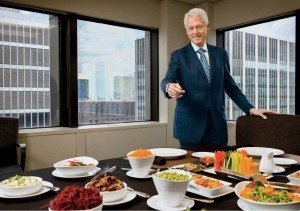 Yet another sign of veganism’s increasing acceptance among the general public: the interview with Bill Clinton in the Aug/Sept. issue of AARP The Magazine. Titled “My Lunch with Bill,” it’s all about his vegan diet, and filled with superlatives. “I’m struck with a dazzling kaleidoscope of a dozen delicious dishes,” described with obvious delight by author Joe Conason. “We sit down and with great relish start passing plates back and forth.” And from Clinton: “I have so much more energy now! I feel great,” adding later, “I decided to pick the diet that I thought would maximize my chances of long-term survival.”
Yet another sign of veganism’s increasing acceptance among the general public: the interview with Bill Clinton in the Aug/Sept. issue of AARP The Magazine. Titled “My Lunch with Bill,” it’s all about his vegan diet, and filled with superlatives. “I’m struck with a dazzling kaleidoscope of a dozen delicious dishes,” described with obvious delight by author Joe Conason. “We sit down and with great relish start passing plates back and forth.” And from Clinton: “I have so much more energy now! I feel great,” adding later, “I decided to pick the diet that I thought would maximize my chances of long-term survival.”
AARP further supports the article by including vegan recipes at the end, as well as on their website with the caption “Eat Like a President.” Plus another webpage of Meatless Monday recipes. Who would have thought, even a few years ago, that this kind of support for veg eating would come relatively soon from major mainstream sources? Clinton is not totally vegan, but he is about 95% there, and is doing highly effective work to encourage ordinary Americans to eat healthier diets. All who dream of a vegan world can be grateful to Clinton and to the many media outlets who have featured his diet.
August 17, 2013
The Girls of Atomic City
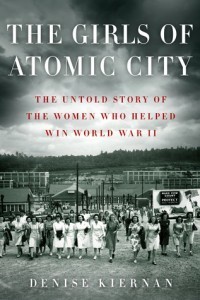 The Girls of Atomic City: The Untold Story of the Women Who Helped Win World War II, by Denise Kiernan. Simon & Schuster, 2013.
The Girls of Atomic City: The Untold Story of the Women Who Helped Win World War II, by Denise Kiernan. Simon & Schuster, 2013.
I visit Oak Ridge, Tennessee, the “Atomic City” of the title, every year because my husband grew up there and we visit his siblings who still live in the area. I knew something of its history, but learned a lot more by reading this. I’d thought the first residents were just a few thousand scientists and their assistants, but in fact the scale of this secret city was huge: 78,000 residents at its peak, including tens of thousands of non-technical support staff; extensive construction, including the largest building on earth; a major bus system; and much more. When the government decided to build a city there, many hundreds of people who had lived on the land, sometimes for generations, lost it in a matter of a few weeks. The amount of money, workers, and resources it took for the single project of enriching uranium for bomb fuel was astonishing.
I liked that the author told the story through the eyes of women of different backgrounds and skills who worked there from Oak Ridge’s inception through the war years. Workers were given only the minimum information to do their jobs, not told what they were helping develop. Security was tight and informants were everywhere. Residents had to deal with frequent waiting in lines, cramped housing, mud everywhere, and a completely unknown future.
This fascinating true story brings up profound ethical issues such as putting science to the use of large-scale killing, how much violence is justifiable for a worthwhile goal (ending a war), medical research without consent (humans injected with plutonium), and the government’s use of people’s labor without telling them the ultimate goal of their work.



